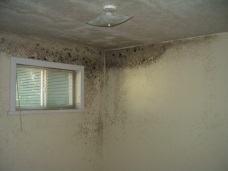What is Mold Sampling and Testing?
 Mold sampling and testing is a fast, reliable way to determine if a home or commercial property has an indoor mold problem. This testing protocol compares the types and amount of mold inside a structure like a home vs. the mold that’s living outside. The outside levels become the benchmark for comparison. A healthy home, a healthy indoor environment, contains lesser quantities of the same species of molds that are observed outside the day of sampling. A mold problem is determined when different species of mold are present inside the home or commercial property, when compared to outside or if certain species are elevated compared to outside levels.
Mold sampling and testing is a fast, reliable way to determine if a home or commercial property has an indoor mold problem. This testing protocol compares the types and amount of mold inside a structure like a home vs. the mold that’s living outside. The outside levels become the benchmark for comparison. A healthy home, a healthy indoor environment, contains lesser quantities of the same species of molds that are observed outside the day of sampling. A mold problem is determined when different species of mold are present inside the home or commercial property, when compared to outside or if certain species are elevated compared to outside levels.
How Is Mold Sampling and Testing Conducted?
An environmental technician conducts the mold testing. The first step of a mold air test is to take an outside air sample to use as the benchmark. A sample is collected using a vacuum pump that captures 75 liters of air on a small, sticky microscope slide. All of the mold spores collected on the slide and any other samples taken, such as tape lifts, are sent to an accredited laboratory.
Turn-Key recommends a minimum of one air sample per level in a home or commercial building and one sample is taken outside. More samples may be recommended based on the square footage or configuration of the property. Visible mold can be easily tested by applying surface clear tape directly to the mold growth. This “tape lift” is then applied to a microscope slide and sent to an accredited lab.
The Turn-Key environmental technician reviews the lab results and writes a report of the finding to provide to the property owner. With this information the owner can make important decisions as to next steps.
What is a Whole Structure Mold Inspection?
A whole structure mold inspection (commercial or residential) includes air sampling and much more. Typically, two environmental technicians inspect the entire structure. The structure is inspected for water intrusion and mold growth. Turn-Key technicians use scientific instruments including moisture meters, Flir thermal cameras and other environmental instruments to measure:
- Wet substructure
- Relative Humidity
- Carbon Dioxide (CO2)
- Temperature.
These readings and findings along with air testing results allow Turn-Key Environmental to prepare a comprehensive report which documents the findings of the investigation and testing. If there is a mold problem the report will document the location of the mold and source of moisture and develops remediation specifications. These specs are provided to a remediation contractor who then uses them as a guide to safely eliminate the documented mold problem.
It is important that the remediation is completed by a certified remediator who is knowledgeable about containment and preventing the remediation from contaminating other areas of the structure. Turn-Key works with the mold remediator and oversees the remediation process. When the remediation is completed, Turn-Key conducts post remediation inspection and air sampling services. This is a second test that mimics the first, to see if the remediation resolved the mold problem. If so, the remediation passes the inspection and the home or commercial property is good to go. If it does not pass the post remediation testing, the remediation is repeated with Turn-Key Environmental providing oversight to in ensure that the remediator is closely following the remediation specifications. Post remediation air sampling and inspection is repeated until clearance is achieved.
To learn more about how we sample mold and conduct air testing, check out our full range of Dayton mold testing services.


